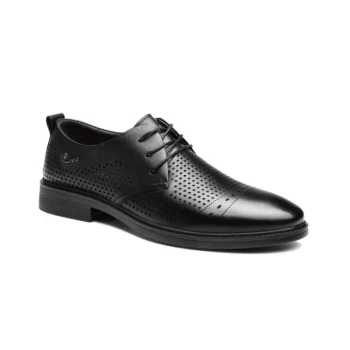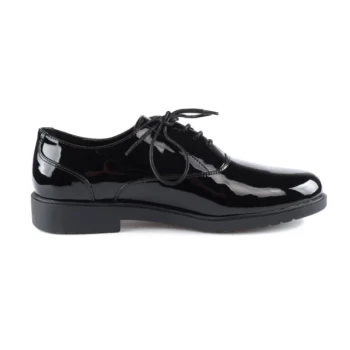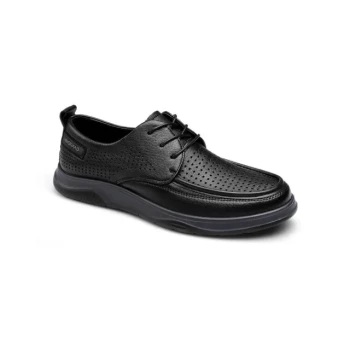At its core, the monk strap shoe has evolved from a single-strapped utilitarian design to a more expressive double-strapped style. This change reflects a broader shift in menswear, where the shoe has become a versatile statement piece that bridges the gap between formal and casual attire. Its defining feature, the buckle system, has moved from a simple closure to a key aesthetic element.
The monk strap’s journey is not just about adding a second buckle; it’s about its transformation from a historical curiosity into a cornerstone of the modern business-casual wardrobe, valued for its unique blend of formality and personality.
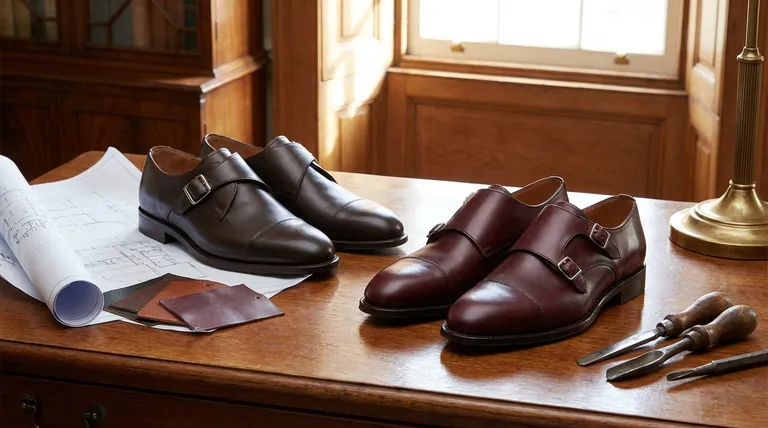
From Monastic Function to Modern Form
To understand the monk strap, you must look to its origins. It was developed centuries ago by monks who needed a more durable and protective alternative to their traditional open-toed sandals.
The Original Single Monk
The earliest and most traditional form is the single monk strap. This design features one wide strap that fastens across the instep with a single buckle.
Its look is clean, understated, and elegant. The single monk is the more conservative of the two main styles, sitting comfortably in professional and formal settings.
The Rise of the Double Monk
The most significant evolution was the introduction of the double monk strap. This style features two thinner straps, creating a more visually complex and assertive look.
Often described as having a military-inspired aesthetic, the double monk became the more popular and fashion-forward variation. It offers more visual interest and is often seen as a deliberate style statement.
Modern Details and Variations
Beyond the number of straps, modern monk straps have adopted details from other classic shoe types. It's common to find them with decorative broguing (perforations) or structured cap-toes. These additions further enhance their stylistic range.
Finding its Place: Formality and Versatility
The monk strap's evolution cemented its unique position in the hierarchy of men's dress shoes. It is neither the most formal nor the most casual, which is its greatest strength.
The Oxford-Derby Spectrum
In terms of formality, the monk strap sits neatly between the formal, closed-lacing system of an Oxford and the more casual, open-lacing of a Derby.
This middle ground makes it an exceptionally versatile shoe. It's formal enough for many suits but relaxed enough to pair effortlessly with chinos, trousers, or even dark-wash denim.
The New Business Casual
The evolution of the workplace, particularly with hybrid schedules, has broadened the definition of "business casual." Strict traditions have given way to more expressive styles that can transition from the office to an evening out.
The monk strap is perfectly suited for this modern environment. Its distinctive buckle closure provides a touch of personality that a standard lace-up might lack.
Understanding the Trade-offs
While highly versatile, the monk strap's unique design comes with specific considerations that are critical to understand.
The Statement Buckle
The buckles are the shoe's defining feature. This inherent boldness means they draw attention, which may not be appropriate for the most conservative corporate environments or somber occasions.
Fit is Non-Negotiable
Unlike a laced shoe that offers multiple eyelets for adjustment, a monk strap's fit is less forgiving. The placement and tightness of the strap are fixed, so finding a last that matches the shape and instep of your foot is crucial for comfort.
Making the Right Choice for Your Style
Your choice between a single or double monk strap should be driven by your primary goal and personal aesthetic.
- If your primary focus is timeless, understated elegance: The classic single monk strap is your ideal choice, pairing perfectly with traditional business wear.
- If your primary focus is a bold, contemporary statement: The double monk strap offers more visual impact and serves as a confident centerpiece for a modern wardrobe.
- If your primary focus is maximum versatility: A brown or oxblood double monk strap with minimal detailing offers the best balance for dressing up with a suit or down with jeans.
Ultimately, the monk strap has evolved to become the definitive choice for the man who appreciates classic footwear but isn't afraid to stand out.
Summary Table:
| Evolution Stage | Key Characteristic | Primary Use |
|---|---|---|
| Original Single Monk | Single wide strap, single buckle | Conservative, formal settings |
| Modern Double Monk | Two thinner straps, more assertive | Fashion-forward, style statement |
| Contemporary Variations | Added broguing, cap-toes | Maximum versatility, business-casual |
Ready to elevate your footwear collection with premium monk straps?
As a large-scale manufacturer, 3515 produces a comprehensive range of high-quality footwear for distributors, brand owners, and bulk clients. Our production capabilities encompass all types of shoes and boots, including classic and contemporary monk strap designs.
We can help you source or create the perfect monk strap shoes to meet your market's demands. Contact us today to discuss your manufacturing needs and explore our extensive catalog!
Visual Guide
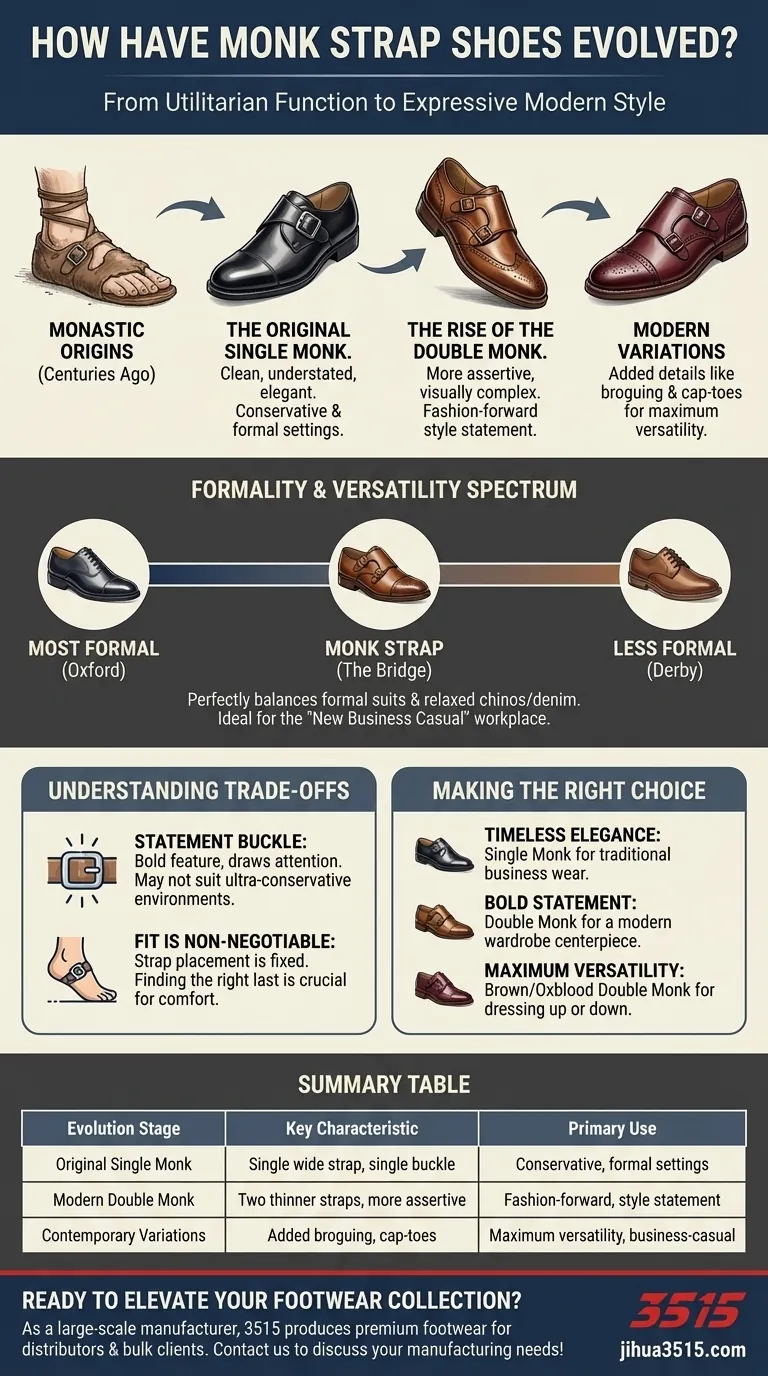
Related Products
- Custom Manufactured Air Cushion Leather Business Shoes for Wholesale
- Wholesale Comfortable Business Casual Shoes Custom Manufacturing
- Wholesale Breathable Perforated Leather Derby Dress Shoes for Custom Brands
- Wholesale Patent Oxford Dress Shoes | Custom & Bulk Manufacturing
- Wholesale Breathable Perforated Leather Derby Shoes with Modern Comfort Sole
People Also Ask
- Why are sneakers now accepted in office environments? The Shift to Modern Professionalism
- What should be considered when choosing sneakers for a business casual office look? Achieve Comfort & Professionalism
- Can trainers/sneakers be worn in a business casual setting? How to Choose the Right Style for a Professional Look
- What are the key features of high-quality leather in shoes? Invest in Durability and a Perfect Fit
- Are sneakers acceptable in a business casual workplace? How to Choose the Right Style


